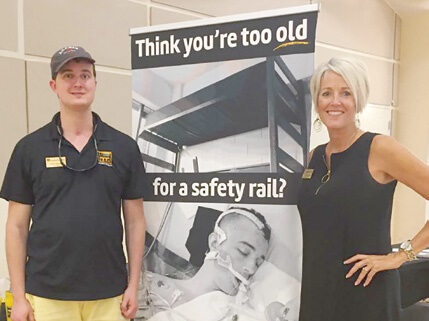Mother Raises Awareness About Bed Safety
Categories: Living with Brain Injury
By Mariellen Jacobs, Founder, Rail Against the Danger
Anyone who has sustained a traumatic brain injury (TBI) knows that life changes in the blink of an eye. In 2015, my son Clark’s life almost ended after a terrible accident at his fraternity house. Of all the campus dangers I thought I knew about when I sent him to college, it turned out to be something that wasn’t even on my “helicopter mom” radar that almost took his life.
I’ll never forget gazing up at the seven foot high lofted bed in Clark’s new room and thinking out loud whether he should have a safety rail. I also remember the laughter from Clark, his dad, and his big sister, Kelsey, as they exclaimed, “He’s not going to roll out of bed!” Remembering that he had just spent a year on the top bunk at his residence hall, I relented.
Four months later, Clark rolled over in his sleep one night, plunging to the hard floor where he landed on the back of his head. He doesn’t remember falling – just coming to while vomiting into a trash can. After vomiting a dozen more times, he had a massive headache and was unable to turn his head. Clark decided then that it was time to call us. We took him to the emergency room, where a CT scan confirmed our fear that he had fractured his skull. During the hours that followed, he developed a brain bleed that required emergency surgery. As the surgeon spoke to us in the waiting room, the words we heard were surreal, “Your son’s brain is hemorrhaging. If we don’t operate, he will die. Even if we do, he may not make it.”

Clark Jacobs and his mom, Mariellen, share information about safety rails at an educational event.
Thankfully, Clark did survive brain surgery. The next 72 hours were spent on pins and needles in the ICU with our son on a ventilator, barely conscious. Within hours of surgery, we were told that Clark had suffered a hemorrhagic stroke in his cerebellum, the part of the brain that controls motor movement, balance, and speech. In the days that followed, we were transferred from the ICU to Shepherd Center, a renowned rehab hospital in Atlanta. He spent the first two and a half months in a near-comatose state. As the days and weeks stretched on with no improvement, we began to wonder if our son was ever coming back to us. Would he ever walk again or entertain us with his trademark sarcasm? The thought of him waking and returning to college seemed a far-off dream.
As I sat by his bed day after day, I found myself wondering how often this type of freak accident happens. My internet research showed that bunk and loft bed accidents weren’t really rare at all, with 71,000 children aged 4-21 reporting to the emergency room every year with severe bed-related injuries. It made me wonder how many parents were just like we were, making residence hall decisions without any idea of the potential dangers. The thought of another family going through this nightmare convinced me that someone had to do something. That is how “Rail Against the Danger” (RAD) was born.
I began a grassroots campaign in the state of Georgia to change perception and policy regarding safety rail usage in the college setting. As sturdy safety rails cost about $40, it’s this mom’s opinion that any bed that is six or more feet off the ground should have a rail on the bed, provided by the institution. Safety rails are instrumental in preventing the unthinkable. Students should also note that thick mattress pads might affect a rail’s efficacy, so be sure to measure and ask for a taller rail if needed.
When I think back to the day that changed our lives forever, I am always struck by the fact that a $40 safety rail would have prevented all of it. Clark will have challenges for the rest of his life from his brain injury and stroke. I encourage everyone to ask questions about bunk and loft bed safety at their universities. If the tragedy our family experienced helps prevent one family from experiencing the same thing, maybe we will all sleep a little better.
For more information about RAD and safety rails, visit railagainstthedanger.org.
Mariellen Jacobs is a mother and safety activist. She works as a brain injury peer support liaison at Shepherd Center in Atlanta, Georgia where her son rehabilitated for 18 months following his accident.
This article originally appeared in Volume 14, Issue 1 of THE Challenge! published in 2020.
